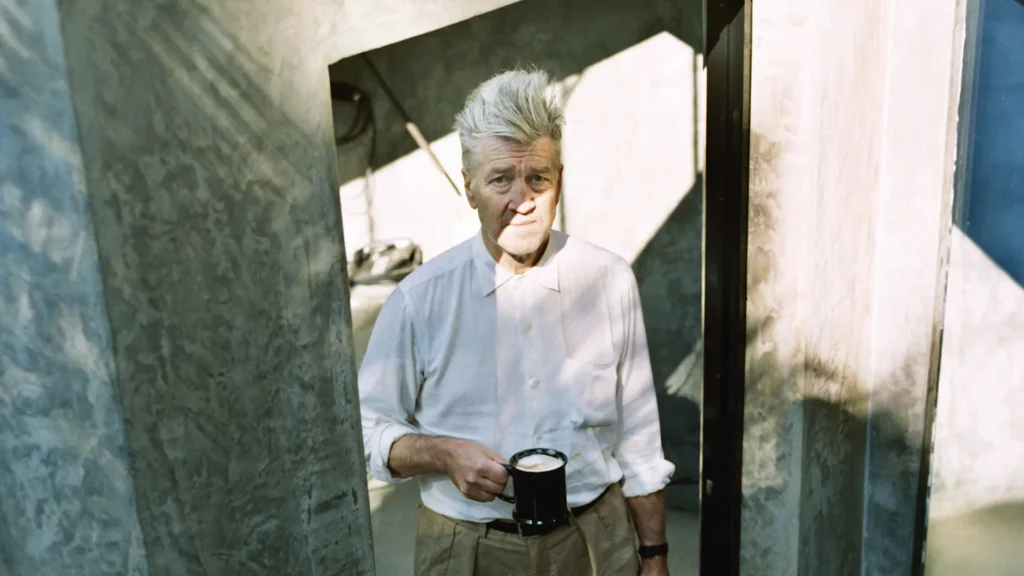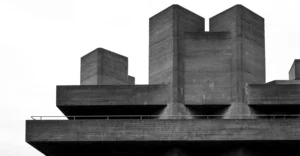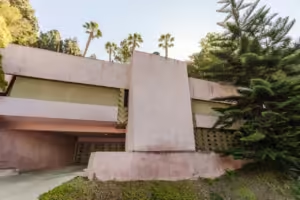
Lynch’s philosophy: Home, Space and Art
If a body can harbour a soul, then what is a house? For David Lynch, the answer was always inseparable from the act of living. David Lynch unlike many artists did not romanticise suffering, he believed that creativity thrived on clarity, balance, and above all, positivity. To him, misery was not a muse but a burden. In an interview with the German design magazine Form, he explained, “The whole space is just pleasing, gives me a good feeling, it affects my whole life to live inside of it. And then, sometimes I see things, shapes or something that would go inside of it and that leads to furniture or film.”
Space was neither passive in his life nor incidental to his practice. His home, like his cinema, was a vessel for imagination, a source of artistic energy and an extension of his psyche. Yet the home in question resists easy interpretation. It is a brutalist structure, functional and unapologetically severe, with asymmetrical concrete blocks that project both honesty and intimidation. Its scale and geometry embody a certain gloom, a harshness. Brutalism does not yield to sentimentality. It insists on its own weight, an architectural style that is a protrusion of reality separate from it yet residing within it, looking unlike it yet reflecting it.
Such a space may feel cold, harsh, unwelcoming and even asphyxiating to the average Joe. But for David Lynch, who made his career out of juxtaposing the ordinary with the ominous, this was fertile ground. Suburban streets, pastel homes, and small-town diners, all become landscapes of unease when Lynch turns his camera on them where the veneer of normalcy barely conceals the ominous and the sinister. The pink brutalist box against the sun-drenched backdrop of Los Angeles embodies the same juxtaposition. What appears incongruous becomes a source of tension, and what feels out of place becomes a portal into the deeper truths of the American experience.
The History of Brutalism in America
 Image source: Carlo Navato
Image source: Carlo Navato
Brutalism itself has a peculiar history in America. It emerged in the 1950s, a product of the postwar era that grew out of the need to rebuild affordably as well as rapidly. Brutalism fit the bill not just in terms of the physical structures that were needed but thematically as well, representing strength, permanence and durability after the war, values that resonated with a country eager to get back on its feet after the war. But the monumental giant blocks of concrete symbolized a permanence and power associated not with civilization and growth but of a mysterious force that grew from within. Brutalism carried with it an authoritarian shadow, an immovable heaviness that seemed less about shelter and more about power. These structures became metaphors for the turbulence of postwar society, the struggling veterans unable to get back in with civil society, the anxieties of the Cold War and the dark insidious nature of capitalism hidden behind its industrial growth, concealing its true motives. It was the housewife smiling over dinner while plotting a murder in the quiet suburbs, the American dream cracking at its foundations.
Lynch’s cinema operates on this same paradox and this is why brutalism and David Lynch feel so inseparable. Both reflect the same contradiction: the surface promise of order masking the chaos beneath. His house, like his films, is not a retreat from reality but a mirror of it, holding within its walls the same uncanny tension that defines his body of work. To walk through its concrete halls is to experience a small piece of his cinema, to feel the American nightmare humming beneath the polished surface of daily life.
Selling a Legacy
 David Lynch’s LA compound (image source: WSJ)
David Lynch’s LA compound (image source: WSJ)
Now, with David Lynch gone and his house listed for sale, the question of legacy emerges with unsettling force. His films, paintings, and art are already in the marketplace, controlled by production companies and collectors. The home, too, is part of that legacy. It was not merely a dwelling but a site of creation, a space that shaped his artistic output. To treat it as a commodity, no different from any other property on the real estate market, risks erasing not just his legacy but America’s legacy.
The listing agent has suggested that the ideal buyer would be a David Lynch devotee, a museum, or a foundation willing to preserve the home as a cultural artifact. Yet the reality is that most often it will be those with deep pockets who win. America has a long history of treating its cultural heritage as a commodity, of packaging even its nightmares for sale. The irony is hard to ignore: a house that stands as both a monument to brutalism and a symbol of Lynch’s unsettling vision of the American psyche now risks becoming just another luxury property, stripped of its very essence.
The question is not just whether Lynch’s house should be preserved but whether America can resist the urge to liquidate its own history for profit. Culture cannot be safeguarded if every artifact, every legacy, is simply transferred to private ownership. To build should not only mean to construct or to profit. It should also mean to preserve, to recognize that architecture, like cinema, carries stories that matter beyond the lifespan of their creators. Lynch’s house is not just concrete and angles. It is a chapter in the broader narrative of American art and American unease.
If his films document the American nightmare, then his house is part of that document. To sell it into obscurity is to allow a piece of the nation’s cultural memory to vanish into private ownership. The nightmare, in this case, would not be confined to the screen. It would be America quietly selling off fragments of its soul.
To read more about how art mirrors life, head to The World Times.



